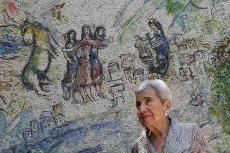|
A Chagall mosaic in her garden...
Thursday, 17 December 2009
by Adrian Higgins
The Record
Washington Post News Service
Evelyn Nef, an arts patron whose storied life is embodied in a monumental
mosaic by the celebrated artist Marc Chagall, died of cancer Dec.
10 at her home in Georgetown. She was 96.
 Chagall
met Mrs. Nef through her late husband, John Nef, and while staying
at the Nefs' house in 1968, he declared his intention to create
an artwork for them. Two days later, he said: "The house is
perfect as it is. I will do something for the garden, a mosaic." Chagall
met Mrs. Nef through her late husband, John Nef, and while staying
at the Nefs' house in 1968, he declared his intention to create
an artwork for them. Two days later, he said: "The house is
perfect as it is. I will do something for the garden, a mosaic."
Three years later, the 10-by-17-foot mosaic was unveiled on a mild
November evening. Embedded in a purpose-built brick wall, it is
rich in mythological imagery juxtaposed with a New World skyline
and huddled immigrants.
The symbolism was not lost on the former Evelyn Schwartz, whose
parents were Hungarian Jews who immigrated to New York in the early
years of the 20th century. What began as a comfortable childhood
went awry when her father died suddenly at 48, leaving a mentally
fragile mother in a state of dumb grief and unable to care for her
four children.
"I remember how silent the house became — the absence
of people, the sudden cessation of music, noise and laughter,"
wrote Mrs. Nef in her 2002 memoir, "Finding My Way: the Autobiography
of an Optimist."
Mrs. Nef overcame the emptiness of her childhood to become, in
various incarnations, a puppeteer, an entertainer who could recall
1,000 songs, an expert on polar exploration, a psychotherapist and
a benefactor of some of Washington's leadings cultural institutions,
including the National Symphony Orchestra, the Washington Opera
and the Corcoran Gallery of Art.
The Chagall mosaic, the only one of its kind in a private garden
in the Western Hemisphere, has been bequeathed to the National Gallery
of Art.
In 1930, at 17, she became a frequent visitor to a bohemian restaurant
in Greenwich Village that became a hangout for artists, writers,
dancers and actors, who would often perform or entertain. One of
the regulars was the architect R. Buckminster Fuller, with whom
she had a brief and eventually unhappy affair.
On the rebound, she met and married the puppeteer Bil Baird, and
together they made marionettes and performed, prone on an 18-inch-wide
plank 50 feet above the stage.
Baird, she wrote, could hold a room "spellbound with a single
marionette, walking it around the room, without any dialogue, making
the marionette climb up on someone's knee or look under a woman's
dress."
She found Baird less attentive as a husband, and they divorced.
Mrs. Nef credited her intellectual development to her second husband,
Vilhjalmur Stefansson, a renowned arctic explorer more than 30 years
her senior.
"The polar world was completely foreign to me, but I made
it my own. I fell in love with the idea of learning everything about
everything, and Stef, with his encyclopedic storehouse of knowledge,
was a rich source of wisdom during this intellectual awakening,"
she wrote. She became president of the Society of Women Geographers.
During their 21-year marriage, which ended with Stefansson's death
in 1962, Mrs. Nef wrote books on polar geography and acted as her
husband's secretary and research assistant. She had administered
her husband's library at Dartmouth College, but widowed at 49 in
a college town, she felt alone. She was offered a job at the American
Sociological Association's new headquarters in Washington, and she
moved there in 1963.
The next year, she met John Nef, an economic historian and University
of Chicago professor, and they soon married. John Nef headed a program
that brought artists, writers and other thinkers in contact with
doctoral students, and his retinue included writer and future Nobel
laureate Saul Bellow and Chagall, who died in 1985. The Nefs vacationed
with Chagall and his second wife, the former Valentina "Vava"
Brodsky, in the south of France during the 1960s.
"In time the four of us became a little family," she
wrote.
Diminutive and with close-cropped gray hair, Mrs. Nef had a sprightly
appearance that seemed to negate her advancing years, and she worked
out regularly. Her husband died in 1988, and she had no immediate
survivors.
The mosaic contains in its lower right corner the image of two
lovers under a tree, prompting her to ask the artist, "John
and me?"
"If you wish," Chagall said.
"I wish," she replied.
Photo by SARAH L. VOISIN, WASHINGTON POST
|


 Chagall
met Mrs. Nef through her late husband, John Nef, and while staying
at the Nefs' house in 1968, he declared his intention to create
an artwork for them. Two days later, he said: "The house is
perfect as it is. I will do something for the garden, a mosaic."
Chagall
met Mrs. Nef through her late husband, John Nef, and while staying
at the Nefs' house in 1968, he declared his intention to create
an artwork for them. Two days later, he said: "The house is
perfect as it is. I will do something for the garden, a mosaic."